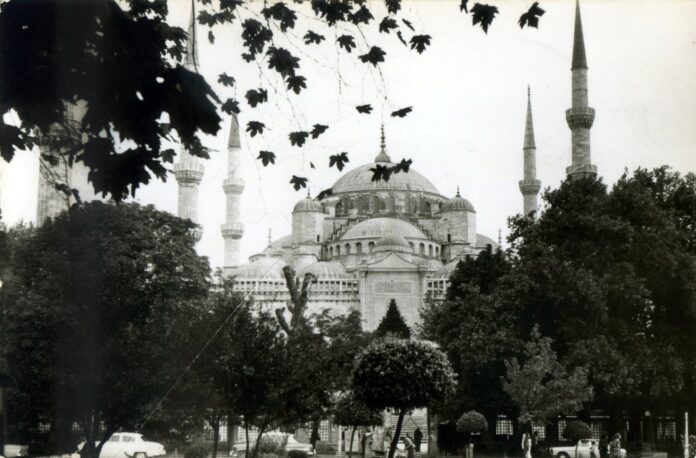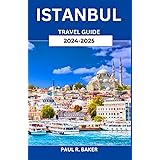© Copyright photo by Levent Ağaoğlu
The magnificent Blue Mosque overlooking Hagia Sophia behind sycamore leaves is an aesthetic masterpiece. An unforgettable architectural masterpiece from centuries beyond, with a chestnut kebab vendor of 1970s car models at the entrance. Blue Mosque 11 October 1975
Çınar yaprakları ardında Ayasofya’ya nazır görkemli Sultanahmet Camii estetik şaheser. Giriş kapısında 1970’lerin araba modelleri kestane kebap satıcısı ile yüzyıllar ötesinden unutulmaz mimari bir şaheser. Sultanahmet Camii 11 Ekim 1975
…………………………………………………
by Doğan Hızlan
I received an important fax from Ambassador Metin Göker , Director General of Cultural Affairs at the Ministry of Foreign Affairs . There is also the Blue Mosque -which is listed as the Blue Mosque- in Millennium’s 10 Ball Buildings , published in New Zealand’s most respected and important weekly magazine, The Listener .
The 10 buildings of the millennium are listed as follows:
Taj Mahal: The tomb built by the Turkish-Indian ruler Shah Cihan (1592-1566) for his wife Mumtaz Mahal (Ercüment Banu Begüm). 20,000 workers worked for 22 years.
Sagrada Familia: Antoni Gaudi ‘s unfinished Holy Family church in Barcelona .
Chrysler Building: Described as the queen of New York skyscrapers.
Potala Palace, Lhasa: This building, which is called the Godzilla of religious buildings, was completed in the 17th century by the Dalai Lama’s palace in Lhasa, which was the capital of Tibet.
Sydney Opera House: This opera house, whose plan was drawn by John Utzen , is defined as the most modern, most magnificent and functional opera house in the world.
Chartres Cathedral: This cathedral in France is the first and largest of the medieval churches. It took its final shape in 1220.
Pompidou Center: It entered this list with its decoration and technology. The most loved and used art center in Paris.
Ulm Cathedral: This building in Ulm , Germany is a symbol of Gothic architecture.
Blue Mosque (Sultanahmet Mosque): The most beautiful mosque in the Islamic world. A mosque completed by the famous architect Sedefkár Mehmed Ağa in 1616.
Bilbao Guggenheim Museum: This museum, which left its mark on Frank Gehry ‘s modernism of the century, was built in Bilbao , the fourth largest city in Spain .
SOME of our readers may ask why not the Süleymaniye Mosque .
According to some historians, Sultanahmet ‘s pioneering in the art of decoration may have played a role against the simplicity of Süleymaniye .
His tiles, reflecting light, may have attracted much more attention from foreign experts. Moreover, the first silhouette that appears when coming from Marmara is that mosque.
I think what Doğan Kuban wrote on the Blue Mosque explains the reason for this choice:
The Sultan Ahmed Complex, realized by ‘Master Architect Sedefkár Mehmet Ağa’, is the last comprehensive project that can be compared with 16th century buildings.
The Yeni Mosque and Sultan Ahmed Mosque, built by Sinan’s students, took the Şehzade Mosque as an example and made variations of it. This choice is important for Turkish architectural history, and it probably proves that their master Sinan and they, and even their patrons, preferred the Şehzade scheme to Süleymaniye.’
The fact that the Taj Mahal is among the 10 structures is also interesting in terms of our architectural history. This tomb, which was built by the Indo-Turkish Emperor Shah Cihan for his wife Mumtaz Mahal (Ercüment Banu Begüm), is considered an important work of Turkish-Islamic architecture.
Suut Kemal Yetkin gives the following information about the architect of the Taj Mahal :
‘The architect of the Taj Mahal, which is one of the world’s leading masterpieces in terms of cleanliness in its lines, harmony in its mass and suitability to its theme, is the son of Turkish architect Yusuf, who was brought up by Koca Sinan and who was called to India.’
***
I think this list summarizes the adventure of all architectural lines in the world over a thousand years.
***
Referenced sources:
Istanbul An Urban History- Byzantion, Constantinople, Istanbul, Doğan Kuban, Translation: Zeynep Rona, Turkish Economic and Social History Foundation.
Art in Islamic Countries, Suut Kemal Yetkin, Cem Publishing House Encyclopedia of Yurt, Great Larousse-Dictionary and Encyclopedia.
Suut Kemal Yetkin and two great encyclopedias agree that the architects and masters who went to India were Turkish, but their names are different. We took the names in Yetkin’s work.
https://www.hurriyet.com.tr/dogan-hizlan-sultanahmet-camii-milenyum-saheseri-39091894




















